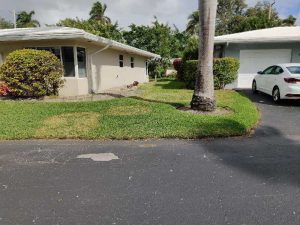If you manage St. Augustinegrass, Zoysiagrass or Bermudagrass you are probably familiar with Large Patch fungal disease, caused by the large patch isolate of Rhizoctonia solani. Some turf managers call the disease Brown Patch, but genome analysis shows that the two are different diseases. Large patch attacks the warm season turfgrasses that we grow in south Florida (called C4 grasses), and especially St. Augustinegrass, Zoysiagrass and Bermudagrass. In southern Florida it is a winter disease. Brown patch attacks the more northern cool climate grasses like fescue, ryegrass and bluegrass (called C3 grasses). However, we have another potentially confusing wrinkle. Brown patch can also affect St. Augustinegrass in the summer. It can make the St. Augustinegrass turf look bad, but does not require fungicide treatment. That is according to Dr. Phil Harmon, plant pathologist with the University of Florida/IFAS.
Large patch has been a big winter problem in southern Florida during the past several years as conditions have been very good for development. In the fall and winter it can cause one to several foot diameter wide damaged circles on lawns. It tends to show up when soil temperatures drop below 75oF (usually sometime in November), and especially if highly soluble or excessive quantities of nitrogen fertilizer have been applied in the fall. However, this nitrogen connection is disputed by some. Like a lot of fungal problems, it is much easier to prevent than it is to eliminate. Additionally, areas that have significantly bad large patch also tend to get it in subsequent years. If large patch is really bad in the winter, it may also persists as a problem into the summer months.
If you are not already confused enough, in comes another Rhizoctonia species, Rhizoctonia zeae. It causes Leaf and Sheath Blight (or spot). One of the key differences with large patch is that it is a summer, not fall/winter disease. So, instead of large patch continuing into the summer, you may actually be dealing with this new species. The taxonomy and therefore scientific name are not fully agreed upon yet, but you may hear it called Rhizoctonia zeae by some turf managers in the know and on fungicide product labels. Other scientific names you may see are Waitea circinata (probably the sexual stage of R. zeae) or even Rhizoctonia oryzae.
Many plant pathology labs will not segregate among these species due to the extra expense for you, and the similarity of recommended fungicides. If identification is important though, R. zeae may be identified by adding thiophanate-methyl (pronounced thI O fan Ate-meth ul) to the petri dish nutrient solution. Some common turfgrass thiophanate-methyl products are T-Methyl, 3336, T-Storm and TM. So, therein lies a practical recommendation if you are managing summer Rhizoctonia in your turf. That is, do not include thiophanate-methyl in your summer turf Rhizoctonia fungicide rotation. Beyond that, and the timing of course, fungicide and management recommendations are the same as for large patch. If you are interested in a research trial-based and slightly more detailed outline of large patch and leaf and sheath blight professional management and fungicide recommendations, please feel free to contact me, Bill Schall at wls@ufl.edu.
Special thanks to Phil Harmon, PhD for reviewing the content of this blog.

 1
1
